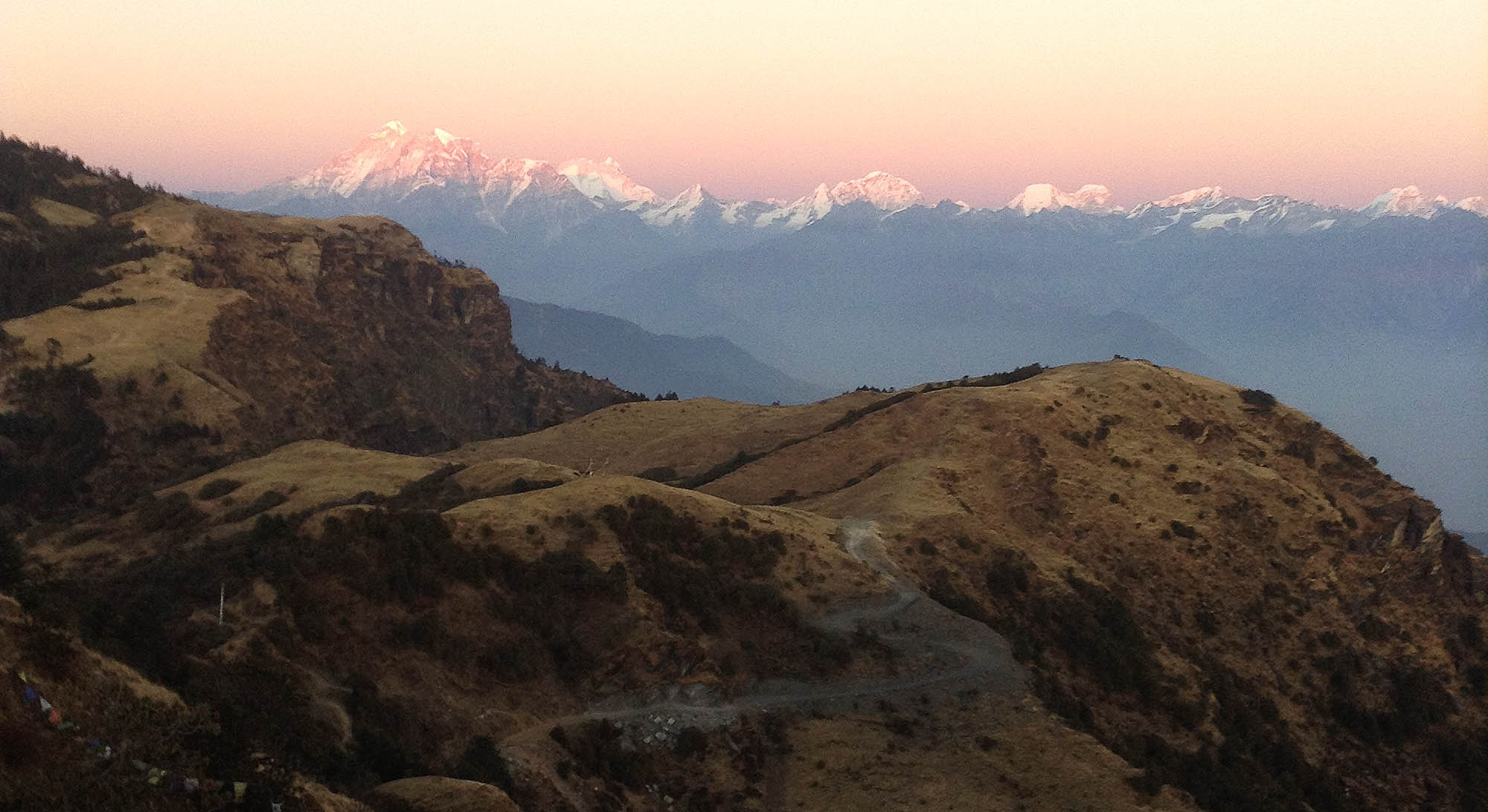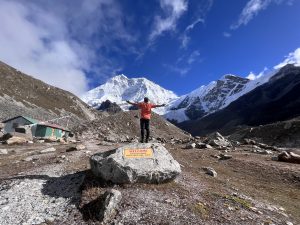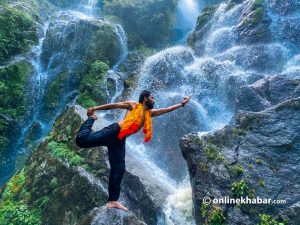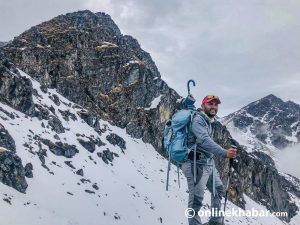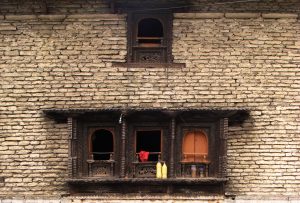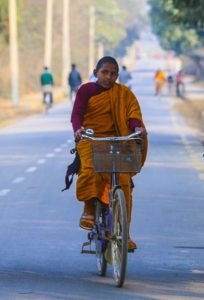The silence and twisted trees gave the place an eerie look. Tufts of old man’s beard gave it a primeval look, like no one had been there in a long, long time.
Our guide motioned to us to stop. We could see no further than thirty feet because of the mist. He pointed to the dank forest floor, a cushiony carpet of leaves in varying stages of decay. There among the leaves was a pile of bear scat. Our guide told us it was dangerous to go further. We abandoned our plan of going to the hill’s peak and turned back.
On the way back to our lodge Sonam, our guide, showed us an opening on the floor in a corner of a meadow. It was a cave, he told us. Technically, it was a small pit. According to him, the “cave” was where an ascetic had meditated for years. Back then the village was only a herdsmen’s summer camp site. I peered in and saw that the cave was ten feet deep. Getting in, let alone spending time there, seemed impossible. But one thing was sure: there would be no disturbances down there.
Outside the cave, the whine of drill entering wood bored into the small village’s tranquility. The village was Kuri. It was known for the shrine of the Kalinchok Bhagwati that sat atop a nearby hill.
(L-r) A man basks in the sun, overlooking the Kuri valley below; Photo: OnlineKhabar. With new wooden houses – hotels – being built everywhere in the valley, Kuri is metamorphosing; Photos: Author. (Opener) Nature imposes certain restrictions in the valley. When it snows, it is impossible for motorbikes to come up all the way to the village; Photo: Author.
Kalinchok, as the small valley was also known, is well-known. Pilgrims came there to seek the goddess’s blessings. Weekenders came for the mountain panorama. A dirt road provided something of an off-road experience for motorcyclists; mountain bikers had a rugged trail to measure themselves against. People came for the quiet, people came for the snow.
The road had made Kuri accessible to those who could not walk up to it. So it was that the village needed more rooms. Hence the whine of the carpenter’s drill instead of the tinkling of bells around cows’ necks.
***
I had first seen Kuri when it was still a village in the classic sense. With no road coming into it, you had to trek.
There were seven or eight wooden houses, clustered together as if for warmth. They were the lodges. And they were right in the middle of the shallow valley, as if honoring some unspoken rule to keep a certain distance between the village and the hill with the shrine. In the evenings (and this, to me, was the most convincing effect) the place would be dark. The only light was the fire over which meals were cooked. When you went out to relieve yourself – and outside was the only option – you walked into another world. The sky was packed with stars and it seemed nearer to the earth, as if the weight of all those twinkling gems made it sag.
The northeastern side of the valley; Photo: OnlineKhabar
But that Kuri was long gone. On that morning when we had to abort the attempt to get to the horn-shaped hill southeast of Kuri, the drill was going mad. Sonam dai emptied the mushrooms we had collected onto a nanglo. We waited for his wife to cook lunch. There was electricity round the clock: a hydropower station in the district meant there would be no blackouts. There would also be, on that morning, no end to the drilling.
Kuri felt like (and it still does every time I visit) a place metamorphosing. A couple of new wooden houses – hotels – seemed to sprout everywhere in the valley. Motorbikes and jeeps and buses could now grunt up to the village. Bathrooms were indoors. There was cooking gas. Hotels were moving ever further up the trail toward the sacred hill. There was even a tea shop thirty-odd feet below the shrine. It was on its way to becoming a town, one new hotel room at a time.
Nature couldn’t actually protect this decline into prosperity, but it did impose certain restrictions. In the monsoon, the road closed for months. When it snowed, it was impossible for motorbikes to come up all the way to the village. They had to be left lower down the road, while the defeated owners walked into Kuri. Branches snapped under the weight of snow and took down the power lines with them: dark evenings returned to the village.
I liked that, the illusion of going back in time. I also liked the fact that in Kuri the movement of humans could be decided by bears, or their scat. Not all is lost in a place like that.
Checklist
While pilgrims come here to seek the goddess’s blessings, weekenders come for the mountain panorama; Photos: Author.
Getting there

If you are the typical Nepali in terms of punctuality (or the untypical non-Nepali who has adopted this nation’s ways) your adventure will begin in the Old Bus Park in Kathmandu as you realize that there are buses in Nepal that do leave on time. That bus is the Super Express, which leaves every morning for Charikot. You can buy tickets at the counter on the northeastern corner of the station.
You will arrive in Charikot around mid-day. It is possible to trek to Kuri on the same day, but it’s a relentless climb (four to six hours). It’s best to stay the night in town and set out early the next morning. Don’t even think about doing the trek in a single day if you are going there in winter—unless you have experienced guides with you.
For those going up there on motorbikes and jeeps, ask the locals for directions to the dirt road to Kuri. Going up this road in the dry season will mean riding through dust clouds. Otherwise it’s an easy ride.
Places to Stay

Hotel Tashi Delek is a family-run lodge that has all the amenities you can expect in a village. The husband knows Kuri and the surrounding area like the back of his hand. Accompanying him on his daily walks into the woods is a tour in local myth and history.
Caution

Kuri is a small village surrounded by a large wilderness. It takes minutes to get to a dense forest from your lodge and, if you are not careful, even less time to lose your way. While trekking up, follow the electric pylons that go all the way up to the valley. If on a walk around Kuri, don’t venture off into the woods alone.
***
Also read
Top five destinations you need to visit to beat winter in Nepal




